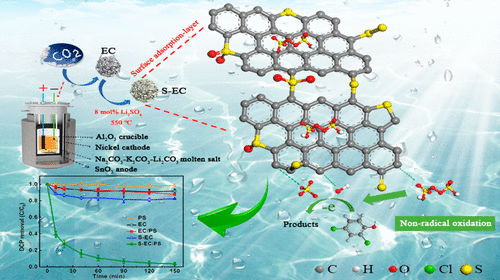当前位置:
X-MOL 学术
›
ACS ES&T Water
›
论文详情
Our official English website, www.x-mol.net, welcomes your
feedback! (Note: you will need to create a separate account there.)
Transforming CO2 into Sulfur-Doped Carbon As a High-Efficiency Persulfate Catalyst for the Degradation of 2,4-Dichlorphenol: Influential Factors, Activation Mechanism, and Regeneration of Catalyst
ACS ES&T Water ( IF 4.8 ) Pub Date : 2021-07-21 , DOI: 10.1021/acsestwater.1c00112 Yongsong Ma 1 , Yuxing Gu 1 , Da Jiang 1 , Xuhui Mao 1 , Dihua Wang 1, 2
ACS ES&T Water ( IF 4.8 ) Pub Date : 2021-07-21 , DOI: 10.1021/acsestwater.1c00112 Yongsong Ma 1 , Yuxing Gu 1 , Da Jiang 1 , Xuhui Mao 1 , Dihua Wang 1, 2
Affiliation

|
The burning of fossil fuels leads to the emission of large amounts of CO2 into the air, and how to deal with the increasingly generated CO2 has been a great challenge. In an effort to convert the low-value CO2 into valuable material, this work proposed sulfur-doped CO2 converted carbon (S-EC) by molten salt carbon capture electrochemical transformation (MSCC-ET) as a persulfate (PS) activator for 2,4-dichlorophenol (2,4-DCP) removal. The catalytic performance of CO2 converted carbon (EC) was dramatically enhanced by sulfur modification. The most efficient dosage of S-EC was 50 mg L–1; the most efficient dosage of PS was 5:1 M for PS/2,4-DCP, and the efficient pH range was 3.0–9.0. The results of radical quenching experiments and electron paramagnetic resonance spectroscopy further confirmed the novel nonradical process in a S-EC/PS system. Furthermore, the novel nonradical activation mechanism of S-EC on PS was further identified on the basis of the results of density functional theory (DFT) calculations and polarization curves. In addition, the degradation intermediates such as 4-chlorophenol, 2-chlorophenol, 2-chlorohydroquinone, and some carboxylic acids were identified by gas chromatography–mass spectrometry (GC–MS), and the possible degradation pathways were summarized. Remarkably, the molten salt redox-sulfidation method can completely restore the catalytic performance of used S-EC for PS. This work extends the application of EC materials for environmental remediation.
中文翻译:

将 CO2 转化为掺硫碳作为高效过硫酸盐催化剂降解 2,4-二氯苯酚:影响因素、活化机制和催化剂再生
化石燃料的燃烧导致大量CO 2排放到空气中,如何处理日益增多的CO 2成为一个巨大的挑战。为了将低价值的 CO 2转化为有价值的材料,这项工作提出了通过熔盐碳捕获电化学转化 (MSCC-ET) 作为过硫酸盐 (PS) 活化剂的硫掺杂 CO 2转化碳 (S-EC) 2,4-二氯苯酚(2,4-DCP)去除。CO 2转化碳(EC)的催化性能通过硫改性显着提高。S-EC 的最有效剂量为 50 mg L –1; 对于 PS/2,4-DCP,PS 的最有效剂量为 5:1 M,有效 pH 范围为 3.0-9.0。自由基猝灭实验和电子顺磁共振光谱的结果进一步证实了 S-EC/PS 系统中的新型非自由基过程。此外,基于密度泛函理论(DFT)计算和极化曲线的结果,进一步确定了 S-EC 对 PS 的新型非自由基激活机制。此外,4-氯苯酚、2-氯苯酚、2-氯氢醌和一些羧酸等降解中间体通过气相色谱-质谱联用(GC-MS)进行了鉴定,并总结了可能的降解途径。值得注意的是,熔盐氧化还原硫化法可以完全恢复使用过的S-EC对PS的催化性能。
更新日期:2021-08-13
中文翻译:

将 CO2 转化为掺硫碳作为高效过硫酸盐催化剂降解 2,4-二氯苯酚:影响因素、活化机制和催化剂再生
化石燃料的燃烧导致大量CO 2排放到空气中,如何处理日益增多的CO 2成为一个巨大的挑战。为了将低价值的 CO 2转化为有价值的材料,这项工作提出了通过熔盐碳捕获电化学转化 (MSCC-ET) 作为过硫酸盐 (PS) 活化剂的硫掺杂 CO 2转化碳 (S-EC) 2,4-二氯苯酚(2,4-DCP)去除。CO 2转化碳(EC)的催化性能通过硫改性显着提高。S-EC 的最有效剂量为 50 mg L –1; 对于 PS/2,4-DCP,PS 的最有效剂量为 5:1 M,有效 pH 范围为 3.0-9.0。自由基猝灭实验和电子顺磁共振光谱的结果进一步证实了 S-EC/PS 系统中的新型非自由基过程。此外,基于密度泛函理论(DFT)计算和极化曲线的结果,进一步确定了 S-EC 对 PS 的新型非自由基激活机制。此外,4-氯苯酚、2-氯苯酚、2-氯氢醌和一些羧酸等降解中间体通过气相色谱-质谱联用(GC-MS)进行了鉴定,并总结了可能的降解途径。值得注意的是,熔盐氧化还原硫化法可以完全恢复使用过的S-EC对PS的催化性能。











































 京公网安备 11010802027423号
京公网安备 11010802027423号